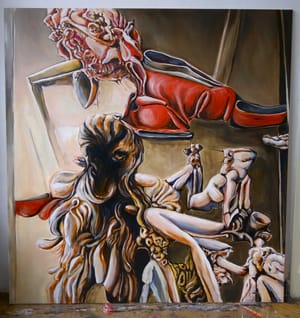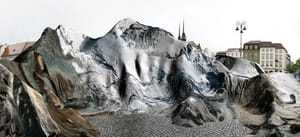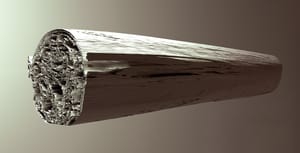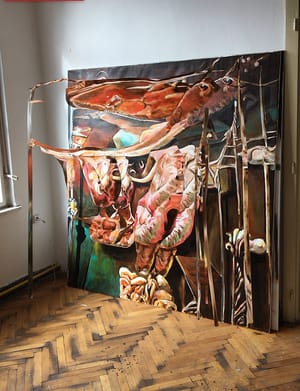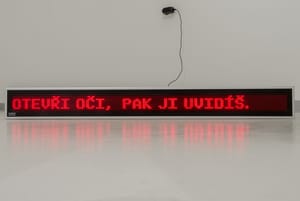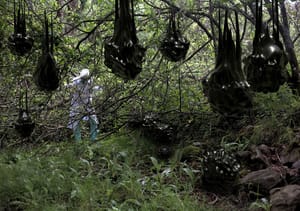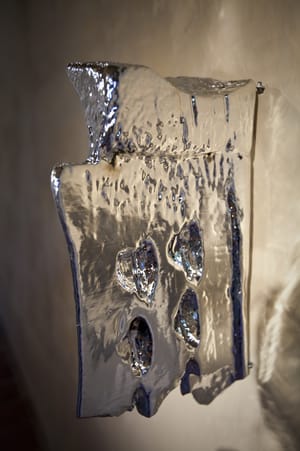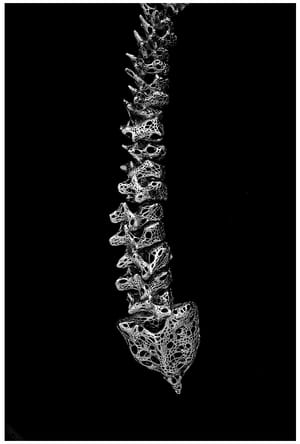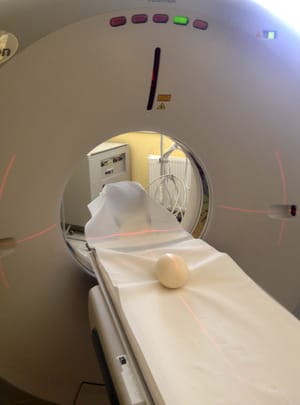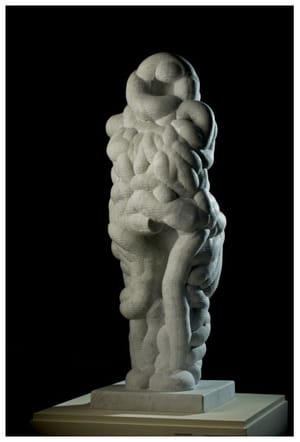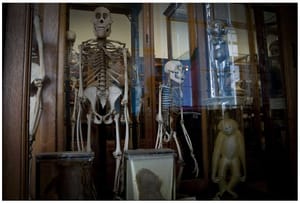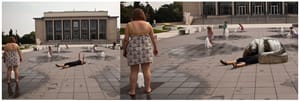- First Name
- Helena
- Surname
- Lukášová
- Born
- 1970
- Birth place
- Brno
- Place of work
- Brno
- Website
- https://helenalukasova.com
- CSU Library
- ↳ Find in the catalogue
About artist
Helena Lukášová is one of the pioneers of digital sculpture. She is also concerned with another related phenomenon – artificial intelligence in the context of art, both on the Czech art scene and internationally. She focused on digital sculpture during her PhD studies at the Academy of Fine Arts in Bratislava (completed in 2009) from which she had received her MA degree in Sculpture under Professor Juraj Bártusz in 1996. The studio led by Juraj Bártusz was called the Studio of Free Creativity because it was open to all sorts of experimentation. At the end of the 1990s, Helena Lukášová travelled to the USA, and this trip greatly affected her further evolution as an artist. She spent six years in the United States, first studying and then working at the Johnson Atelier Technical Institute of Sculpture in New Jersey where she got acquainted with digital sculpture. Thanks to the intensive time she divided between commissioned work performed in the institute’s workshops and her own work created in the same space, she gained skills that only few artists, let alone those from Central Europe, could attain.
Helena Lukášová takes a completely innovative approach to sculpture which is considered one of the most traditional artistic genres. Since 2003 she has been working at the Department of Visual Informatics (Faculty of Informatics, Brno University of Technology) as the head of the Graphic Design and Multimedia Studio. She uses sculpture and objects as a means to explore the world’s physical matter – literally and figuratively, both in reality and virtually. She navigates the virtual world with unseen confidence, while using new technologies as her sculptural instruments.
Some of her works eventually become real and tangible artefacts – such as the project Jsem Venuše (2014), for which she received the Rector’s Award of the Masaryk University in Brno. In this project, she drew the silhouette of her own body using a programme for creating artworks in a virtual environment that perceives real space using sensors. The resulting “Venuses”, i.e. the materialized contours of her own body created by this programme, gave rise to a series of 3D prints that were subsequently rendered in marble during the artist’s residency in Italy. The marble sculpture is now situated in a sculpture park in New Jersey, whose curator focuses specifically on works created using new technologies. However, some of Helena Lukášová’s works remain “only” in the realm of the virtual, or in augmented reality. By the time most of the world was forced to the online space by the pandemic, she had already made it her home.
A characteristic feature of her work are ambiguous or multivalent shapes of her objects. They often resemble extraterrestrial creatures, mutated aliens, amorphous beings that seem to have come from another planet. In fact, they often inhabit parallel, virtual realities whose existence is conditioned by technology. They are only visible by means of smart devices, most often those archaically called telephones. It is only thanks to them that the augmented reality appears and offers us an unexpected view of ordinary places. We can see, for example, the world’s highest mountain, Mount Everest, the Vegetable Market in Brno or a flower-trolley in front of Tate Modern, which we would never be able to do if we just stayed off-line.
The principle of mutated artwork derived from real shapes can also be found in the artist’s series of watercolours entitled Unnatural Selection (2019). The series works with variations created by artificial intelligence based on photographs. The interpretation of these “phantasmagoric” scenes is drawn by the human hand, producing an unsettling impression of mutated creatures of unknown species. It is as if our brains, looking at these watercolours, wanted to assemble the “correct” image of a human being or an animal. And yet we know that what is presented to us is exactly what we can see – a cluster creating a hazy reflection of our own human experience.
Helena Lukášová also pushed the physical boundaries of the human body during her participation in the collection by designer Denisa Nová (autumn/winter 2015/16), for which she created unique masks and a jewellery collection. The masks that were produced using 3D printing resembled parasitic creatures, mineral deposits covering the faces of the posing models. The central theme of a separate set of ornaments was the concept of Milagros, referring to votive objects known in Spanish and Latin American culture, which are supposed to grant wishes to their owners. The artist created miniature versions of various body parts of close family members using a 3D scanner. She cut the objects into pieces and reassembled them into various combinations. These creations were subsequently gilded to become exclusive fashion accessories.
A pivotal part of Helena Lukášová’s work is also her collaboration with her sister, photographer, theoretician and multi-genre artist Veronika Lukášová under the name HEVER. Their creative activities included a project called Research, as part of which they have been exploring dark matter – the matter of the universe – since 2018. By inventing her own form of this unknown substance, placing it in a real landscape and engaging human participants dressed in white coats to represent doctors, explorers and researchers, she has been creating a parallel story of a known, and yet undescribed substance.
Although Helena Lukášová is most often labelled as a sculptor, she combines various disciplines with the same ease as she pushes the boundaries of art itself. For her, new technologies are as natural as, for instance, a chisel for most sculptors. It is no exaggeration to say that her work plays a fundamental role in the development of art, or rather in the history of art. It is not difficult to imagine her name in an imaginary dictionary alongside the pioneers of digital sculpture. It can be expected that her endlessly innovative work will meet with even greater interest in the future.
- Author of the annotation
- Michaela Banzetová
- Published
- 2021
CV
Studium: 2005–2009
Doktorské studium, zaměření: digitální socha, Vysoká škola výtvarných umění v Bratislavě
2002–2003
Credit courses of Computer Art and Digital Imagin, Mercer County Community College, New Jersey, U.S.A. 1998–2002
Výuční program na the Johnson Atelier, Technical Institute of Sculpture, certifikovaný program v sochařských technikách – (výroba forem, odlévání a pronásledování voskem, smrk, malba a patina, řezba do kamene) Princeton, New Jersey, USA 1992
Výměnný pobyt – Slippery Rock University, Pensylvania, USA 1990–1996
Magisterské studium, obor: socha, Vysoká škola výtvarných umění v Bratislavě 1985–1989
Střední uměleckoprůmyslová škola v Uherském Hradišti Praxe: 2003 – dosud
Vyučující na Fakultě informatiky, Masarykova univerzita Brno,
Vedoucí ateliéru grafického designu a multimédií, Katedra vizuální informatiky 2013–2015
Vyučující kurzu 3D modelování na Vysoké škole výtvarných umění v Bratislavě 2002–2003
Asistence při technické realizaci soch z kovu a kamene ( Kiki Smith, Jon Isherwood, George Segal, Charles Ray, Magdalena Abakanowicz, Julian Schnabel and others) a výuka studentů výučního programu Art Instructor, Johnson Atelier, Technical Institute of Sculpture, Princeton, NJ, U.S.A. 1997–1998
Vyučující Módní kresby, Střední škola umění a designu, Brno 1997–1998
Vyučující Modelování z hlíny, Janáčkova akademie múzických umění v Brně
Členství v porotách, ocenění, účast na konferencích: 2020–2021
Člen poroty – 6th international Digital Sculpture Competition / the non-profit international association ARS MATHEMATICA, based in Paris (France), is organizing the sixth International Digital Sculpture Competition (DSC) on the occasion of INTERSCULPT 2020, an exhibition presented at the Galerie Maître Albert, Paris (posponed to May 2021) 2020
Příspěvek na konferenci Interior, Exterior / International Science and Art Conference Wyzsza Szkola Humanisticzna, Wroclaw , invited speaker, PL 2020
Vědecké ocenění MUNI, ocenění týmu Masarykovy univerzity za výzkum v oblasti digitální rekonstrukce barona Trencka, následované výstavou v muzeu města Brna a odbornou publikací CZ 2020
TIM Masterclass invited speaker, CZ 2020 2019
Gloria Musaealis 2019 cena za výstavu Baron Trenck - Nová tvář legendy v Muzeu města Brna CZ 2019 2018
Invited Lecture at Stellenbosch University, SA, 2018 2017
International Sculpture Center Conference 2017, panelist at the panel discussion: Defining Pressure: Examining the State of Objects in Contemporary Making (other panelist: Michael Rees, Lauren Ewing, Robert Gero), Nelson Atkins Museum of Art, Kansas City Ocotber 25 - 28, 2017 2016
Czech Grand Design nominace
Designblok 2016, prezentace projektu Dissectiong the Universe, Exhibition Grounds, Praha
Czech Grand Design Award – Nejlepší designer roku 2015 v kategorii šperk, ceremoniál a ocenění 2016
Hostující vyučující na William Paterson University, USA 2015
Ocenění rektora Masarykovy univerzity za dosažené výsledky v oblasti výtvarného umění
Recipient of the Lighton International Art Exchange Program (LIAEP) award
Participation at 3D Printed Fashion Desing Show at the 3D Expo at Javits Center, curator Natacha Alpert, New York
Prezentace kolekce Podzim/Zima2015/16 vzniklé ve spolupráci s Denisou Novou, šperky a boty vytvořené metodou 3D tisku, Mercedes Benz Fashion Weekend, Praha 2014
Nominee for the 3D Print Show Global Award, London 2000
Director’s Award, Ellarslie Open, Trento City Museum, Trenton, NJ, USA 1998
Apprentice Grand, Johnson Atelier,Princeton, NJ, USA
Série masek vytvořených technikou 3D tisku pro kolekci Denisy Nové S/S 2014, modní přehlídka na Mercedes Benz Fashion Weekend, konání v DOX, Praha, duben 2014 2013 – 2014
Osmiměsíční stipendium od Ministerstva vzdělávání Slovenské Republiky na Vysoké škole výtvarných umění v Bratislavě, Bratislava
Digitální rekonstrukce obličeje mumie Hereret z sbírky Muzea v Moravské Třebové společně s doc. RNDr. Petrou Urbanovovou, PhD. z Antropologického Ústavu Masarykovy univerzity v Brně, 2012 2012 – 2014
Ateliér digitálního sochařství a multimédií, tříletý projekt OPVK, společně s Fakultou výtvarných umění VUT v Brně 2012
Project Martial Woman, together with Veronika Lukasova, publisher at the Excerp Magazine #3, Australia
- Member of art groups not included in ARTLIST.
- HEVER, spolek Svitava – zakládající člen, Ars Mathematica
Exhibitions
- Solo exhibitions
-
2019
Miluji věci, mlčenlivé soudruhy/ I love Things, the Silent Commrades, Pitevna Gallery, Brno, CZ
2017
Trans_Forma / The Bone Phone, společný projekt s Michael Rees, Galerie středočeského kraje (GASK), Kutna Hora, CZ
2016
Kolekce šperků „Jsi tím, co si přeješ“/Jewelry collection "You are what you wish for", Moravská galerie v Brně – budova Muzeum užitého umění /Museum of Applied Arts, Brno
2000
Absolut Music, with Jordinem Isipem, Mercer County Community College, NJ., USA
Inua, Extension Gallery, Johnson Atelier, Princeton, NJ, USA
1999
Inua, Johnson Atelier Atelier Gallery, Princeton, NJ, USA
- Group exhibitions not included in ARTLIST.
-
2020
Merzbau Revisited Vasulka Kitchen, Centrum pro nová média, Brno
Projekt prezentován během Brno Art Week 2. - 8. 11. 2020
Humain - konference a výstava, téma umělá inteligence v umění, Industra, Brno, CZ
Intersculpt at the DAAP Virtual Sculpture Park, presenting virtual sculpture, Design and Architecture, Art and Planning College, Cincinnati, USA
2020 –2019
Mezinárodní bienále malých forem 2019 - 2020, putovní výstava: Jan Koniarik’s Gallery Trnava, Kysuce Gallery Oscadnica , Turcianska Gallery Martin, M. A. Bazovskeho Gallery Trencin, UMELKA Gallery Bratislav, SK 2019
2019
Presentation of group Ars Mathématique at Salon Culture at Jeux Mathématique, Paris 2019
2018
Open Source, LACDA Los Angeles Center fot Digital Art, 2018
2017
International Bienalle of Small Format Sculpture 2017, Jan Koniarik’s Gallery Trnava, ASP Gallery Wroclaw, 2017
2016
K.E.G.A., intervence do veřejného prostoru, Medium Gallery, Bratislava
Výstava finalistů Czech Grand Design Award, Technické museum Praha
2015
CRAFT FORMS 2015, Wayne Art Center, PA, curated by Ron Labaco from MAD NYC
FASHION-STL:CZ, 3D Print Show, La Fabrika, Prague, 30. 10. 2015
DENISA NOVA A/W 2015, White Box Gallery, GASK, Galerie Středočeského kraje Kutná Hora
Bienále malých forem, Palfyho palac, Bratislava, 2015
Plastic me, Gallery X, Bratislava
Beyond the Buzz: New Forms, Realities, and Environments in Digital Fabrication, Minneapolis College of Art and Design (MCAD)
2014
Rock Stars, Robotic Sculpture in Tuscan Stone M.U.S.A. ( Museo virtuale di scultura e dell'architettura), Pietrasanta June 2014, Museo Archeologico Nazionale di Firenze September, Italy, 2014
A VISUAL SYNTAX Art, in the Book Format, Rack and Humper Gallery, New York
3D Print Show, New York
2013
3D Print Show, London, Paris
International Biennale of Small Format Sculpture, Galerie PK Pezinok, SK
Abominog, Artworks Gallery, Trenton NJ, USA
2012
Chunches de mar, art workshop for invited artists, Montezuma, Costa Rica, exhibition Chunches de Mar, 2012 at the Galeria Nacional, San Jose, Costa Rica
Home Sweet Potato, Gallery Médium, Bratislava
2010
Recherches la feme, Gallery Médium, Bratislava
Deset let Ateliéru grafického designu a multimédií na fakultě informatiky, Masarykovy univerzity, Galerie U dobrého pastýře, Brno
2009
Socha v mestě, Bratislava
2007
Sculpture S.O.S, Gallery Médium, Bratislava
Celebrating Digital Art, Straube Center, Pennington, NJ, USA
2003
Iron Sculpture, juried exhibition, Grounds for Sculpture, NJ, USA
Selected Works, One Room Gallery, Brooklyn, New York, USA
2002
A la Atelier, Greensboro Artist League Gallery, NC, USA
1999 – 2000
Ellerslie Open, juried exhibition, Trenton City Museum, NJ, USA, 1999, 2000
1996
Diplomové práce, Slovak National Gallery, Bratislava
1995
Paralely II, Galerie u bílého jednorožce, Klatovy
Barbakan, Národna galéria Banská Bystrica, SK
Buildhauerei společná výstava se studenty ateliéru Jana Koblasy, Fach Hochschulle. Kiel, D
1994
Slovak Art, Newcastle, UK, 1994
Crossroads, Cultural Center of Poland, presentation of Central Europiens schools of fine arts, London, UK
1991
Paralely, goup exhibition with students of Budapest Academy, Budapest, HU
- Collections
- Zhmotnění myšlenky / Objectification of a Thought – Rektorát Masarykovy univerzity, ve sbírce Masarykovy univerzity, Brno, od 2019 Pitvání vesmíru / Dissecting the Universe – zastoupení v kolekci šperků ve stálých sbírkách Moravské galerie v Brně (budova Užitého umění), Moravská galerie v Brně, od 2016 Jsi to, co si přeješ / You are what you wish for – zastoupení v kolekci šperků ve stálých sbírkách Moravské galerie v Brně (budova Užitého umění), Moravská galerie v Brně, od 2016 Jsem Venuše / I am Venus – ve stálých sbírkách Ground for Sculpture, Princeton, NJ, od 2014
- Other realisations
Inua - cement sculpture, Grounds for Sculpture, NJ, USA, od 2001
Monography
- Monography
2021
Sborník – Humain
LUKÁŠOVÁ Helena
(Článek ve sborníku makáme teď na tom) 2020
BARON TRENCK Nová tvář legendy
URBANOVÁ Petra, VACHŮT Petr, HLOUCHOVÁ Kateřina, JURDA Mikoláš, KOMOSNÝ Cyril Josef, LUKÁŠOVÁ Helena, OSTRÝ Ctibor
(Odborná kniha)
Rok: 2020, vydání: Vyd. první, počet stran: 189 s. 2018
Intuice
(Sborník)
LUKÁŠOVÁ Helena Článek ve sborníku: 2017
Defining Pressure: Examining the State of Objects in Contemporary Making
LUKÁŠOVÁ Helena
(Sborník - aplikace nových technologií v sochařské praxi)
LUKÁŠOVÁ Helena
(Článek ve sborníku)
Trans_Forma / The Bone Phone
LUKÁŠOVÁ Helena
(Článek v odborném periodiku)
Trans_Forma / The Bone Phone
LUKÁŠOVÁ Helena, MICHAEL Rees 2016
Umělecké realizace
Digitální výroba a nové podoby designu, konference Design na hranici, UTB Zlín
LUKÁŠOVÁ Helena
(Článek v odborném periodiku)
Uplatnění 3d modelování v sochařské praxi 2015
Ateliér grafického designu + multimédií Fakulty informatiky Masarykovy univerzity : Studio of Graphic Design + Multimedia Faculty of Informatics Masaryk University
LUKÁŠOVÁ Helena
(Článek v odborném periodiku Safe Place - katalog k projektu) 2014
NEWRON 0.97
CHMELÍK Jiří, KOZLÍKOVÁ Barbora, HUMPOLÍČEK Pavel, DOLEŽAL Milan, HOJNÝ Antonín, JAREŠOVÁ Miroslava, BELLA Ján, HROŠ Michal, ULBRICH Pavol, LUKÁŠOVÁ Helena, POUZAR Tomáš
Software 2012
Rekonstrukce podoby moravskotřebovské mumie. Antropologická analýza a vědecká rekonstrukce podoby obličeje
LUKÁŠOVÁ Helena, URBANOVÁ Petra
(Kapitola v knize)
Ve stínu pyramidy. Příběhy moravskotřebovské mumie, vydání: Vyd. 1, rok: 2012, počet stran: 6 s.
- Articles
2020
N & N Magazín pro Prahu a Berlín: O poznani a pevnych bodech, interview
Digitální baron, Computer časopis, interview 2016
Artmix, profilová prezentace, Česká televize
New Direction for 3D Printing, Core 77 (on-line), interview
Lushic, (on-line), interview
